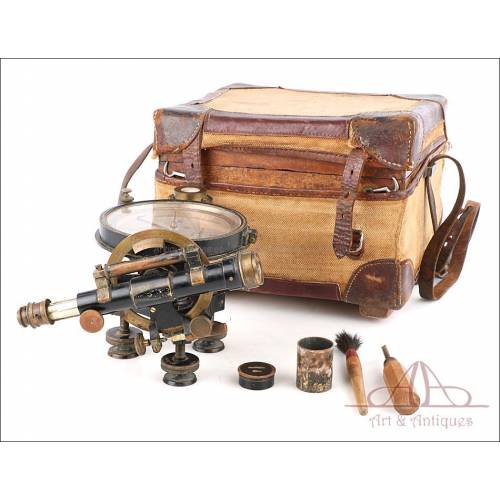D-899
Antique Troughton & Simms Theodolite. England, Circa 1920
Complete English Troughton & Simms theodolite in working order. With original case and accessories.
Sold!
Superb antique Troughton & Simms theodolite made in England circa 1920, complete and in its original storing case. This singular device is complete and is accompanied by some accessories, among them a plum bob and some clamping elements. It is made of brass and preserves the original bubble levels in fine condition, while the optics allow a good focus. The compass is original and is signed by Troughton & Simms London, being also in good working order. Some parts show dirt and dry grease, but it could be enough to submit them to a simple cleaning process in order to regain their operability. It is the case of the eyepieces mobile part, the scale and the lens needed to read it, which though showing this feature are in good condition and remain functional. On the other hand, one of the lenses clamping elements is bended (photo 13) but fulfills perfectly its duty. The theodolites storing case bears a label inside with the name of the original distributor in Spain, located in Bilbao. It is made of mahogany wood and is protected by a leather sleeve. The theodolite is surely a magnificent item, original from the time, made by a prestigious English brand. This antique Througthon & Simms is a collectors piece, perfect to become part of a complete collection of old-time scientific instruments. Dimensions: Foots Width: 5.51 in / 14 cm. Telescopes Length: 12.2 in / 31 cm. Total Height: 12.2 in / 31 cm.Troughton & Simms History Troughton & Simms was a British scientific-instrument manufacturing company founded in London in 1826 by Edward Troughton and William Simms. Throughton had already owned a similar business that he inherited from his father. On the other hand, Simms had trained as a goldsmith and worked dividing circled for fine astronomic instruments. When Simms died in 1860 his part of the business was assumed by his son James and his nephew William. The Troughton & Simms shop was located in Fleet Street and it eventually became the focal pont of the best scientific instrument manufacture in London. Among their customers were the Greenwich Observatory and the famous surveying and exploring expeditions of the time. Nevertheless and in spite of the great reputation of their quality instruments, the company received many complaints from their customers because of their delays in delivering the instruments (delays that could last for years). In 1915 the business became a limited company and in 1922 it merged with T. Cooke & Sons, becoming Cooke, Troughton and Simms.


























